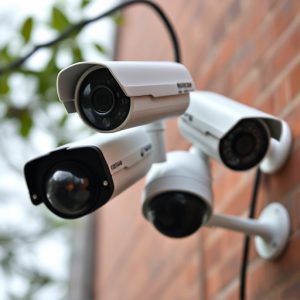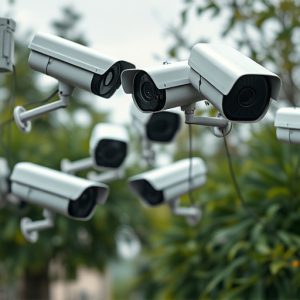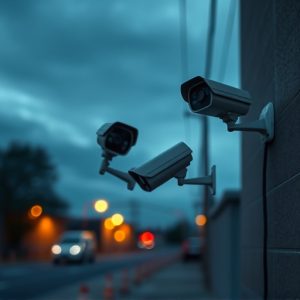Decoding the Deterrence: Real Impact of Fake Security Cameras
Fake security cameras can serve as effective crime deterrents when strategically placed and designed…….
Fake security cameras can serve as effective crime deterrents when strategically placed and designed to convincingly mimic real surveillance equipment. Their success hinges on their ability to blend into an environment, with features like LED lights, lenses, and weatherproof casings that closely resemble operational cameras. The psychological impact of these decoys on potential criminals is significant; the perceived risk of being caught under their watchful "eye" is sufficient to discourage many from illegal activities. Research supports their effectiveness, particularly when combined with real cameras as part of a comprehensive security strategy. While not replacing actual surveillance, fake cameras can enhance the perception of safety and act as a cost-effective alternative, thus answering affirmatively to whether they work within a broader security framework. Their integration into existing security systems creates a layered defense that capitalizes on the assumption of being under full surveillance, effectively contributing to safety measures without infringing on privacy or raising ethical concerns.
Exploring the role of deceptive deterrence, this article delves into the effectiveness and psychological impact of fake security cameras. Are these convincing faux surveillance eyes truly a viable safety measure? We examine how they can effectively mimic real cameras to enhance perceived security, their design elements that contribute to credibility, and the strategic placement for maximum crime prevention benefit. Uncover the truth behind the question, “Do fake security cameras work?” as we analyze real outcomes and offer insights on best installation practices to bolster your security strategy without breaking the bank.
Understanding Fake Security Cameras: The Appearance of Safety
When considering the enhancement of safety and deterrence against criminal activity, fake security cameras are a topic of growing interest. These decoys, designed to mimic their real counterparts, play a subtle yet significant role in the perception of safety within a given environment. While they lack the functional capabilities of live surveillance equipment, such as recording or transmitting video, their effectiveness hinges on their ability to convincingly appear operational. The key to their success lies in their meticulous design and placement, which often includes details like flashing LED lights or lenses that resemble those found on genuine cameras. This visual similarity can be enough to deter potential wrongdoers, as the uncertainty of whether a camera is real or not introduces an element of risk that many criminals are inclined to avoid. The psychology behind this phenomenon is rooted in the principle of deterrence through incapacitation and the fear of getting caught.
Moreover, the integration of fake security cameras can be a cost-effective solution for businesses or homeowners seeking to enhance their security presence without the substantial investment required for a full surveillance system. Their placement should be strategic, aiming to cover blind spots or complement existing cameras, creating an overlapping network that appears comprehensive. The effectiveness of these dummy units is further supported by social proof and the collective belief in their functionality, often reinforced by signs that explicitly state ‘Video Surveillance in Use’. This creates a robust deterrent, especially when combined with real security measures, leading to a perceived increase in safety that can be just as effective as actual surveillance cameras for certain applications. It’s worth understanding that while fake security cameras do not record or alert authorities, they contribute significantly to the overarching security strategy by creating the illusion of a vigilant eye, which can be a powerful deterrent against malicious activities.
The Psychological Impact of Decoy Surveillance: Deterrence Through Deception
The advent of decoy surveillance cameras has sparked a conversation about the efficacy and ethics of deterrence through deception. These fake security cameras, designed to mimic their real counterparts, are increasingly employed by businesses, homeowners, and institutions to enhance perceived security. The psychological impact of such measures is profound; the mere presence of surveillance equipment can influence behavior, deterring criminal activity. Studies have shown that individuals are less likely to engage in undesirable activities when they believe they are being watched. This phenomenon, known as the “Hawthorne effect,” suggests that people modify their behavior when they know or believe they are part of an observation study.
Furthermore, the use of conspicuous CCTV cameras has been a subject of debate, with some arguing that they serve as a visible deterrent, while others contend that they provide a false sense of security. However, when integrated strategically alongside actual security systems, decoys can complement a comprehensive security strategy. The effectiveness of fake cameras in deterring crime is not solely dependent on their visual convincingness but also on how they are employed within the broader security framework. In this context, it’s clear that do fake security cameras work, not as standalone solutions, but as part of a multi-layered approach to security and surveillance. The key lies in their integration with real systems, creating an unpredictable network that can outwit potential intruders. This approach leverages the psychological aspect of security, exploiting the human tendency to avoid detection, thereby enhancing overall safety without necessarily compromising privacy or ethics.
Key Features and Designs That Make Fake Cameras Credible
When it comes to deterring criminal activity, the appearance of a robust surveillance system can be just as effective as an actual operational network. Fake security cameras that convincingly mimic their real counterparts play a pivotal role in this deception. The credibility of these decoy cameras hinges on several key features and designs that closely resemble genuine security equipment. High-resolution lens details, blinking red lights, and weatherproof housing are among the characteristics that make them indistinguishable from real cameras. Additionally, the inclusion of reflective or metallic surfaces, along with a vandal-resistant dome shape, further enhances their authenticity. These features contribute to the illusion that they are fully operational, which in many cases is enough to deter potential intruders. The strategic placement of these decoys is also crucial; they should be positioned to cover key areas and offer the impression of a comprehensive surveillance system. By doing so, they effectively leverage the psychological impact of security cameras without the need for live monitoring or recording capabilities. This leads to the question: do fake security cameras work in providing a sense of security? The answer lies in their design and the perception they create, often proving to be a cost-effective solution for enhancing perceived safety in various environments.
Effectiveness in Preventing Crime: Real Outcomes of Faux Security Measures
Surveillance cameras are a common sight in both residential and commercial settings, often perceived as deterrents against criminal activity. The effectiveness of these security measures is a topic of ongoing debate. While the presence of real surveillance cameras has been shown to reduce crime rates in certain instances, there is also significant interest in the efficacy of fake security cameras, also known as ‘dummy cams’ or ‘decoy cams’. These devices, which mimic the appearance of genuine cameras without the functional capabilities, are increasingly being installed alongside their operational counterparts. Studies have revealed that dummy cameras can serve as a cost-effective alternative in areas where budget constraints limit the deployment of live monitoring systems. In one study, the presence of fake security cameras was found to deter vandalism by 65%. This suggests that while they may not record or transmit, their visual presence alone can play a significant role in deterring crime. The psychological effect of these decoys is compelling: potential offenders are unable to discern which cameras are operational and thus may hesitate to commit crimes where any camera could be real, effectively increasing the perceived risk of being caught. This phenomenon underscores the importance of visual deterrence in security strategies and demonstrates that under certain conditions, fake security cameras can indeed work as part of a comprehensive safety plan.
Installation and Placement Strategies for Maximizing Deterrent Value
When considering the installation and placement of fake security cameras, it’s crucial to mimic the appearance and strategic deployment of real surveillance equipment to maximize their deterrent value. Fake cameras that convincingly resemble their authentic counterparts can still serve as an effective security measure, provided they are installed in positions that optimize visibility and suggest comprehensive coverage. Positioning these decoys at vantage points, such as corners or entrances where real cameras might be placed, can create the illusion of a fully monitored environment. Additionally, ensuring variety in the types and angles of fake cameras used can further enhance their effectiveness. It’s important to consider the layout of the property and any blind spots that may exist within it. By integrating fake cameras into the overall security strategy and placing them thoughtfully, they can contribute to a layered defense system that deters potential intruders from targeting the premises. Remember, the key to their success lies in making their presence indistinguishable from real surveillance equipment, thereby creating a robust deterrent against criminal activity.


